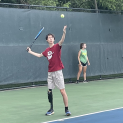STING Pathway Activation: The Missing Link between Genomic Instability and Antitumor Immunity in Osteosarcoma

Project Goal:
Project Update 2024:
In cancers including osteosarcoma (OS), malfunctioning DNA replication results in a warning signal to the immune system via the cGAS-STING pathway, which we believe is modified in OS tumors to evade immune-mediated tumor killing. We have identified that about 50% of OS patient-derived cell lines respond to cGAS-STING activation with a drug treatment, whereas the other half do not. Additionally, using RNA sequencing, we defined the specific genetic changes that occur in OS upon activation of the cGAS-STING pathway. Our preliminary studies of a STING activating drug in animal models have shown that this therapy can slow tumor growth and increase anti-tumor immunity. Overall, we have discovered two subsets of OS with differing capacity to generate an anti-tumor immune signal and demonstrated the benefits of activating STING in patients and in immune assays. Our proposed ongoing work will confirm the effects of STING activation, supporting the translation of this novel approach to activating immune surveillance in osteosarcoma.
Final Project Update 2025:
We identified that cell lines with the highest degree of cGAS activation have STING in an OFF state, and lines with low cGAS activation have STING in an ON state and retain the capacity to produce downstream signals through this pathway. We tested this relationship between cGAS activity and STING repression by treating STING-OFF cells with a cGAS inhibitor. cGAS inhibition results in increased STING protein levels, suggesting that chronic activation of cGAS may result in repression of STING. Additionally, using bulk RNA sequencing, we have defined the specific genetic changes that occur in osteosarcoma upon activation of the cGAS-STING pathway. This osteosarcoma-specific “gene signature” is only present in a small subset of patient samples, but these patients have significantly improved disease-free and overall survival. Importantly, we also identified that a STING activating drug also slows growth of osteosarcoma tumors in small animals by increasing anti-tumor immunity. Overall, we have discovered two subsets of osteosarcoma with differing capacity to generate an anti-tumor immune signal and demonstrated the benefits of activating STING in patients and animal models, supporting the translation of this novel approach to activating immune surveillance in osteosarcoma.

